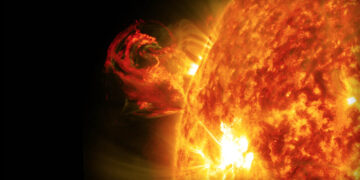Solar flares have long captivated scientists for their immense energy and the disruption they cause on Earth. Now, a groundbreaking discovery has opened the door to more reliable space weather predictions. NASA’s Solar Dynamics Observatory (SDO) has unveiled a phenomenon that could act as an early warning system for solar flares.
The Science Behind Solar Flares
Solar flares are nature’s fireworks, releasing vast amounts of energy in the form of electromagnetic radiation. These eruptions occur when magnetic field lines on the Sun twist and snap, typically around sunspots—darker regions on the Sun’s surface. The buildup and release of this energy can project radiation across the solar system, often causing temporary radio blackouts on Earth.
What makes solar flares particularly impactful is their ability to release coronal mass ejections (CMEs). These are clouds of charged particles that, if directed at Earth, interact with our magnetic field and cause geomagnetic storms. The May 2024 geomagnetic storm, one of the strongest in 21 years, serves as a reminder of how powerful and unpredictable these events can be.
The Flickering Signal: A New Warning System
Recent research has revealed that coronal loops emit subtle flashes of ultraviolet light before a solar flare. These flickers, invisible to the naked eye but observable through NASA’s advanced instruments, provide a predictive window of two to six hours. This discovery stems from the analysis of 50 solar flares captured by the SDO, showing that this flickering accurately signals impending flares with 60–80% accuracy.
The study also found that the intensity of the flickering correlates with the strength of the flare, offering additional insight into the scale of the event.
Why Solar Flare Prediction Matters
Space weather predictions aren’t just about observing the cosmos—they have real-world implications. Inaccurate or delayed forecasts can disrupt modern infrastructure, from satellite communication to electrical grids.
For instance, in the past year alone, solar storms have knocked multiple satellites out of low-Earth orbit due to unexpected atmospheric fluctuations. GPS systems, critical for navigation and even agricultural machinery, have experienced malfunctions during severe geomagnetic storms. In extreme cases, geomagnetic currents generated by solar activity can overload power grids, leading to widespread outages.
By providing a more reliable method to predict solar flares, the flickering phenomenon could help avert such disruptions. Early warnings mean satellites can be placed into safe modes, power grids can prepare for surges, and industries reliant on GPS can mitigate potential losses.
The Solar Maximum: A Surge in Activity
The Sun is currently in its solar maximum, the most active phase of its 11-year cycle. This period is characterized by an increase in sunspots and solar flares, creating heightened risks for space weather-related disruptions.
The timing of this discovery couldn’t be more critical. With heightened solar activity, the potential for geomagnetic storms and their subsequent effects on Earth is significantly greater.
The Challenges Ahead
While the discovery of flickering ultraviolet light is a significant leap forward, there are challenges to overcome. More observations are needed to confirm the accuracy of this method and ensure its applicability across different solar conditions.
One of the biggest hurdles lies in integrating this discovery into existing space weather forecasting systems. Real-time monitoring and analysis of these flickers require advanced computational tools and coordination among space agencies worldwide. Additionally, each solar flare is unique, and researchers must account for these variations when developing predictive models.
Future Directions in Solar Research
The potential for this discovery extends beyond predicting solar flares. By studying the flickering patterns in greater detail, scientists hope to gain deeper insights into the Sun’s magnetic field and the dynamics of its plasma.
Ongoing advancements in solar observation technology, such as the Parker Solar Probe and the upcoming European Solar Orbiter, will play a pivotal role in this endeavor. These missions aim to study the Sun’s atmosphere and magnetic field up close, providing complementary data to the SDO’s observations.
Furthermore, collaboration among international space agencies and researchers will be essential in translating this discovery into practical applications. The integration of flickering-based predictions into global warning systems could set a new standard for space weather forecasting.
A Step Forward in Understanding Our Star
The flickering ultraviolet light in coronal loops is more than just a curiosity—it’s a clue to understanding the Sun’s dynamic processes. This discovery highlights the importance of continued investment in solar research and the development of advanced observational tools.
As we uncover more about the Sun’s behavior, we not only gain the ability to protect our technology and infrastructure but also deepen our connection to the cosmos. The Sun, while a giver of life, is also a force to be reckoned with, and understanding its rhythms is a testament to human ingenuity and perseverance.
Conclusion
As researchers continue to study the Sun’s behavior, we inch closer to unlocking its mysteries and mitigating its risks. The Sun’s flickers are more than just a warning—they’re a reminder of the intricate dance between our planet and its star, and the immense potential of science to illuminate the unknown.
For more information about solar flares and space weather, visit NASA’s Solar Dynamics Observatory website or explore the latest research on space weather forecasting.



















